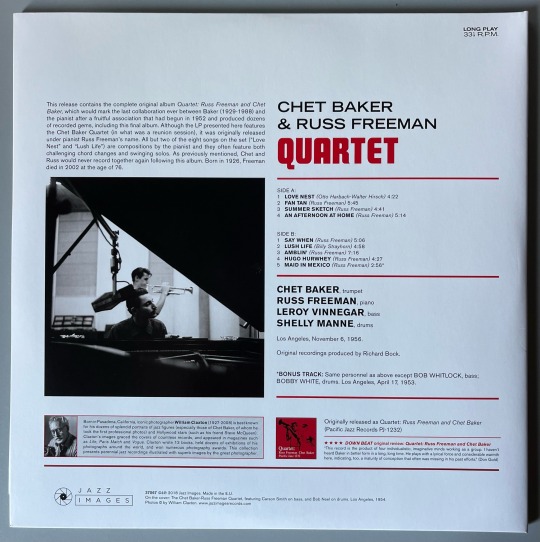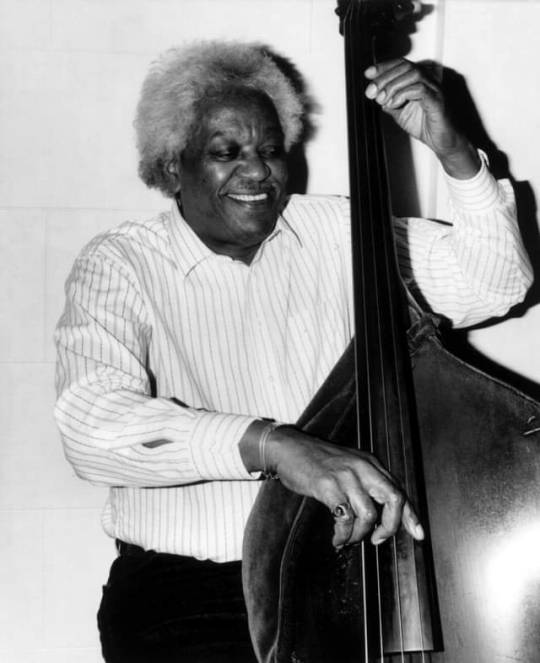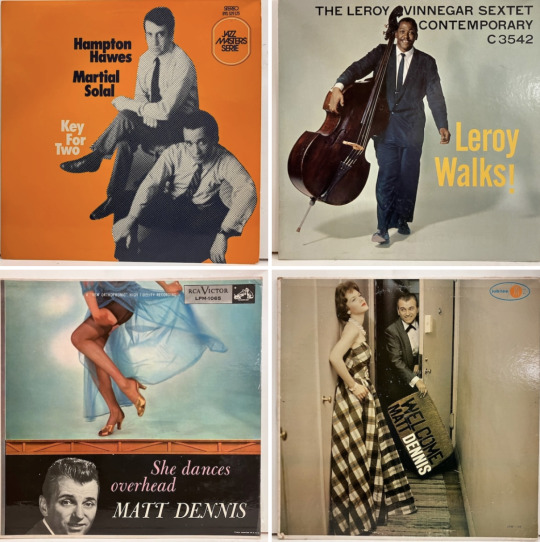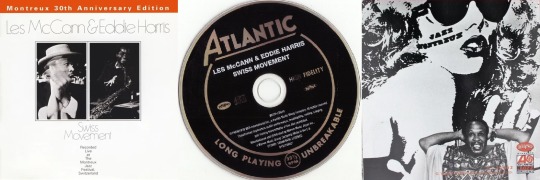#Leroy Vinnegar
Explore tagged Tumblr posts
Text



Chet Baker & Russ Freeman Quartet
#jazz#music#vinyl#audiophile#vinyl albums#vynilcollection#vinylcollector#vinyloftheday#vinylcommunity#chet baker#russ freeman#leroy vinnegar#shelly manne#saxophone#joshi_es
11 notes
·
View notes
Text
Leroy Vinnegar Leroy Walks Again!! Full Album
youtube
4 notes
·
View notes
Text
The Genius of Keys: A Deep Dive into "The Great Jazz Piano of Phineas Newborn Jr."
Introduction: When it comes to jazz piano, few names evoke as much admiration as Phineas Newborn Jr. Known for his dazzling technique, boundless creativity, and deep musical soul, Newborn remains one of the great yet often underappreciated pianists in jazz history. His 1963 album, “The Great Jazz Piano of Phineas Newborn Jr.,” is a testament to his exceptional talent and an essential listening…
#Art Tatum#Benny Golson#Bobby Timmons#Bud Powell#Classic Albums#Count Basie Orchestra#Duke Ellington#Harold Mabern#Irving Gordon#Irving Mills#Jazz History#Leroy Vinnegar#Louis Hayes#Miles Davis#Milt Turner#Mulgrew Miller#Oscar Peterson#Phineas Newborn Jr.#Sam Jones#Sonny Rollins#The Great Jazz Piano of Phineas Newborn Jr.#Thelonious Monk
3 notes
·
View notes
Text

1956 - Shelly Manne and his Men - Rouge Lounge - River Rouge, Michigan
Shelly Manne, Charlie Mariano, Russ Freeman, Leroy Vinnegar, Stu Williamson
6 notes
·
View notes
Text

Album art for Leroy Vinnegar's 1973 soul jazz album Glass of Water
0 notes
Text

Song of the Day - “Compared To What”
Today marks the 55th anniversary of the recording of this fantastic track.
On June 21st, 1969, Les McCann and Eddie Harris laid down their superlative version of this standard tune, in concert at the Montreux Jazz Festival in Switzerland. ...
Written by Gene McDaniels, “Compared To What” had been covered by some 270 artists…
But THIS is the version…
With Les McCann on piano and vocal, and Harris on tenor sax, backed by Leroy Vinegar on bass, Benny Bailey on trumpet, and Donald Dean on drums, they tweaked the lyrics a bit to reflect the current angst with the Vietnam War. … see the lyrics below in comments…
A great track… best played pretty loud…
Resonates profoundly today…
(Mary Elaine LeBey)
youtube
I love the lie and lie the love A-Hangin' on, with push and shove Possession is the motivation that is hangin' up the God-damn nation Looks like we always end up in a rut (everybody now!) Tryin' to make it real, compared to what? C'mon baby!
Slaughterhouse is killin' hogs Twisted children killin' frogs Poor dumb rednecks rollin' logs Tired old lady kissin' dogs I hate the human love of that stinking mutt (I can't use it!) Try to make it real, compared to what? C'mon baby now!
The President, he's got his war Folks don't know just what it's for Nobody gives us rhyme or reason Have one doubt, they call it treason We're chicken-feathers, all without one nut. God damn it! Tryin' to make it real, compared to what? (Sock it to me)
Church on Sunday, sleep and nod Tryin' to duck the wrath of God Preacher's fillin' us with fright They all tryin' to teach us what they think is right They really got to be some kind of nut (I can't use it!) Tryin' to make it real, compared to what?
Where's that bee and where's that honey? Where's my God and where's my money? Unreal values, crass distortion Unwed mothers need abortion Kind of brings to mind ol' young King Tut (He did it now) Tried to make it real, compared to what?!
Tryin' to make it real, compared to what?
Donald Dean, Leroy Vinnegar, Benny Bailey, Eddie Harris
16 notes
·
View notes
Text

Les McCann & Eddie Harris – Compared To What
Compared to What” is a composition, with lyrics, by Gene McDaniels. It was recorded by Roberta Flack in 1969, but became better known following a performance by Les McCann (piano and vocals) and Eddie Harris (tenor saxophone) at the 1969 Montreux Jazz Festival, which appeared as the opening track on their album Swiss Movement. The album was certified Gold in sales in the United States. The song has been covered by more than 270 artists, including Ray Charles.
Les McCann – piano, vocals Eddie Harris – tenor saxophone Benny Bailey – trumpet Leroy Vinnegar – bass Donald Dean – drums
9 notes
·
View notes
Text

Omega Radio for February 24, 2014; #47.
Laura Nyro “Buy And Sell”
Tim Weisberg “Killing Me Softly With His Song”
Smoke “Shelda”
Gianni Oddi “Kimono Pop”
William B. Tanner “The Cat”
Jacky Giordano “Train”
Puccio Roelens “Northern Lights”
Blue Mitchell “Delilah”
Phil Upchurch & Tennyson Stephens “South Side Morning”
Eddie Harris & Les McCann “Set Us Free”
Joe Simon “It Be’s That Way Sometimes”
Rance Allen Group “Give My All To You”
Exuma “Silver City”
Orchestra Julian “Do It With Class”
Modern Soul Band “5 Hach Nalb 7”
Eddie Bo & Inez Cheatham “Lover And A Friend”
Black Sugar “Kathy”
Lalo Schiffrin & The Mike Curb Congregation “Burning Bridges”
Blackrock “Yeah Yeah”
Bayete “Free Angela (Thoughts…And All I Got To Say)”
Michael De Albuquerque “Sweet Mirth”
Gladys McFadden & The Loving Sisters “Never Gonna Turn Around”
Jeannie Reynolds “I’m Hooked On You”
Riff Raff “Original Man”
General Lee & The Space Army Band “We Did It Baby” part 1 & 2
John Tropea “Can’t Hide Love”
Teddy Lasry “Los Angeles”
Gil Flat “End Of A Story” part 2
Leroy Vinnegar “Doing That Thing"
Modern Sound Quartet “Eerie Night”
Pierre Arvay “Sky Way”
Rubba “Way Star”
Guru Guru “Taoma”
Bill Summers “Brazilian Skies”
George Duke “Feel”
Herbie Hancock “Spiraling Prism”
Tony Hymas “Final Inspection”
Azymuth “Fly Over The Horizon (Vôo Sobre O Horizonte)”
Bonus broadcast of vinyl treasures, sampling, crate-digging, soul, funk, groove, R&B, jazz, and fusion.
#omega#music#playlists#mixtapes#vinyl#sampling#crate-digging#funk#soul#groove#R&B#jazz#fusion#Azymuth#Herbie Hancock#George Duke#Bill Summers#Phil Upchurch#Laura Nyro
7 notes
·
View notes
Text
Ron Carter is a legend. That's right. An 87-year-old musician who has put his double bass (and also his cello) on more than 3500 records, both his own and those of others. He has worked with Miles Davis, Thelonious Monk, Wes Montgomery, Don Ellis, George Benson, Eumir Deodato, Antonio Carlos Jobim, Chet Baker, Stan Getz and many other giants of popular music. Not for nothing is he considered one of the greatest double bass players in history, along with Ray Brown, Milt Hinton and Leroy Vinnegar. With three Grammies on a resume that could take three lifetimes, the musician from Ferndale, Michigan, still proves that he has a lot to say. There is no doubt that his legend is not exhausted.
(Source: villanosdeljazz,es)

Ron Carter es una leyenda. Tal cual. Un músico de 87 años que ha puesto su contrabajo (también su chelo) en más de 3500 discos, tanto propios como ajenos. Que ha trabajado con Miles Davis, Thelonious Monk, Wes Montgomery, Don Ellis, George Benson, Eumir Deodato, Antonio Carlos Jobim, Chet Baker, Stan Getz y muchos otros gigantes de la música popular. Por algo se le considera uno de los mejores contrabajistas de la historia, junto a Ray Brown, Milt Hinton y Leroy Vinnegar. Con tres Grammies en un currículo que daría para tres vidas, el músico de Ferndale, Michigan, aún demuestra que tiene mucho que decir. Es indudable que su leyenda no se agota.
(Fuente: villanosdeljazz,es) Publicado en: Pasión por el jazz y el Blues
youtube
4 notes
·
View notes
Text

Regarded as the ‘Master of the Walking Bass,’ Leroy Vinnegar was a mainstay on jazz recording sessions from 1952 on where he was on over 600 dates. His signature walking bass was the foundation for his impeccable sense of swing, which has gone on to influence several generations of players.
Vinnegar was born into a musically inclined family in Indianapolis, Indiana, on July 13, 1928. His earliest musical education came from the radio, on which he listened religiously to the great bands of Duke Ellington and Count Basie. His two sisters played piano, and young Leroy thought that might be his instrument as well. “I tried my hand at piano,” he says, “and I would have been a nice piano player, had I stayed with it.” Things changed when he actually started playing with others, however. “The bass player used to leave his instrument at the house after we’d rehearse,” Vinnegar remembers, “and I just started messing with it, and the next thing you know I was playing the bass. We just got a communication going.”
When he was about 24, Vinnegar considered pursuing his muse on a grander scale. “I was getting ready to make my push,” he recalls. “I knew I had to get out of Indianapolis, so I could get my music career started. There were good musicians in Indianapolis, but I wanted to move up the ladder, so I figured I’d move to Chicago and tune up, and then I would go to New York.” That was 1952, and Vinnegar was shocked to discover that the Windy City was something far more challenging than a momentary stopover. “Little did I know Chicago was just as fast as New York,” he recollects with another hearty laugh. “I thought I would just go there and get ready for the big one. Little did I know I was walking into a lion’s den. They were there waiting for my ass.”
Vinnegar found himself to be “the tenth bass player on the totem pole” in a hierarchy of jazz bassists topped by Israel Crosby and Wilbur Ware. “When you’re new, you just have to wait your turn,” he says. But Vinnegar’s turn was not long in coming. “All the bass players were busy one week,” he remembers, “and somebody said, ‘Hey there’s a new bass player in town by the name of Leroy Vinnegar.’ ‘Well, how does he play, man?’ ‘They say he can play, you know?’ ‘Well, we ain’t heard him.’ ‘Let’s try him and see. There ain’t nobody else here we can get.’”
Soon, Vinnegar was playing in a band with Chicago’s great native tenor saxophonist Von Freeman, and then, with a brotherly boost from Israel Crosby, in the house rhythm section at the famous Bee Hive. There, he had the chance to work with Lester Young, Ben Webster, Johnny Griffin, Sonny Stitt, and others. “It’s hard to pinpoint a single influence,” Vinnegar says, “because everyone I played with or made a record with was such an influence on my career. But I think Art Tatum topped ’em all. He gave me such a nice compliment by wanting me to join his trio. I figured if Art Tatum asked me to join his trio, I must be doing something right.”
It was while playing with Bill Russo at the Blue Note, opposite Tatum, that Vinnegar was heard by the great pianist. “He heard me and wanted me to move to Los Angeles to join his trio,” the bassist recalls. “I was going to move anywhere.”
Shortly after he arrived in Southern California in 1954, Vinnegar insinuated himself indelibly into that scene. “They say it was much better in the ’40s, but for me, everything was happening,” he says, citing the L.A. presence of Dexter Gordon, Wardell Gray, Conte Candoli, Teddy Edwards, Frank Morgan, Hampton Hawes, Carl Perkins, Shorty Rogers, Zoot Sims, Stan Getz, Bud Powell, and many more. Ensconced again in a house rhythm section, this time at Jazz City, Vinnegar played regularly with pianists Kenny Drew, Carl Perkins, and Hampton Hawes, and drummers Lawrence Marable, Frank Butler, and for a while, Philly Joe Jones. He recorded with virtually everyone on the scene, formed a band with saxophonist Teddy Edwards, drummer Billy Higgins, and pianist Joe Castro, toured with Shelly Manne, and helped Les McCann put together his pioneering trio in 1960.
By then, at the urging of Contemporary’s Les Koenig, Vinnegar had already recorded his first albums as a leader"Leroy Walks!, in 1957, followed by Leroy Walks Again! “I was real nervous, wondering what I could do,” Vinnegar remembers. “Les said he wanted me to do songs that had the word ‘walk’ in them. That made it a little easier.”
The “walk,” of course, referred to the inimitably sturdy “walking” style that Vinnegar had perfected, a style he says came to him “because I couldn’t solo. I didn’t know the bass well enough, because I’d never studied it,” he elaborates. “I was just going by ear. I didn’t know the positions or the sound of the fiddle so whenever it got to me, I couldn’t solo and I just stayed right with the walking. It was a safe thing at the beginning, a sure shot, then it started developing into something. I found I had a lot of imagination for the walking bass.” That imagination had been fueled by singing bass in gospel choirs as a youngster, and it became invaluable for both Vinnegar and the musicians around him. “It gave other players a cushion to work off and it sort of woke up the bass players, too,” he says. “It gave people an understanding of what the bass could really do beyond going one, two, three, four.” Today, that understanding is as widespread as the respect that Vinnegar has garnered as the walking master.
Except for occasional recording sessions (such as Teddy Edwards’s breakthrough Mississippi Lad), festival appearances, and European tours, Vinnegar is content to play his regular gigs in Portland. “I’d been coming up to Oregon since 1973 and I fell in love with it,” he says. “Then I met some nice musicians up here and we started creating something, so I said I’ll stay right here. And I’m glad I did, because people up here accept real jazz.” And that’s what Vinnegar plays, with all the honesty and determination that “the Walker” has always embodied.
In 1995, the Oregon State Legislature honored him by proclaiming May 1 Leroy Vinnegar Day.
Leroy Vinnegar died August 3, 1999.
Source: AllAboutJazz/Wikipedia
14 notes
·
View notes
Text


ERIC KLOSS - First Class Kloss ~PRESTIGE 7520 {orig} w/Jimmy Owens, Walton RARE
#karliekloss #imgmodels #beatles #klossmusic
0 notes
Text
1/30 おはようございます。 Matt Dennis / Dennis Anyone Lpm1134 等更新完了しました。
Jaye P. Morgan / Lately PLP-S6540Matt Dennis / Dennis Anyone Lpm1134Matt Dennis / Welcome Matt jgm1105Matt Dennis / She Dances Overhead Lpm1065Ella Fitzgerald / Lady Time 2310825Hampton Hawes Martial Solal / Key For Two byg529125Leroy Vinnegar / Leroy Walks C3542John Coltrane / The Believer prt7292本田竹曠 / T Honda Meets Rhythm Section Featuring S Watanabe pa-9718本田竹曠 / Jodo pa-9720Gary Bartz /…

View On WordPress
1 note
·
View note
Text
Serge Chaloff: The Baritone Saxophone's Unsung Virtuoso
Introduction: The world of jazz is full of transformative figures, musicians who pushed the boundaries of their instruments and paved new artistic paths. Among the baritone saxophonists, Serge Chaloff remains a standout—a trailblazer whose lyrical playing and adventurous spirit elevated an often-overlooked instrument to the forefront of jazz. Despite his brief life and struggles with personal…
#Blue Serge#Charlie Parker#Dizzy Gillespie#Duke Ellington#Four Brothers#Gerry Mulligan#Harry Carney#Herbie Steward#Jazz History#Jazz Saxophonists#Julius Chaloff#Leroy Vinnegar#Madame Chaloff#Manuel Valerio#Margaret Chaloff#Nick Brignola#Pepper Adams#Philly Joe Jones#Serge Chaloff#Sonny Clark#Stan Getz#Woody Herman#Woody Herman&039;s Second Herd#Zoot Sims
1 note
·
View note
Video
youtube
With These Hands- Les McCann and Others
Drums: Donald Dean Violin: Emanuel Green Cello: Harvey Shapiro Producer: Joel Dorn Cello: Kermit Moore Bass Guitar: Leroy Vinnegar Piano, Vocals: Les Mccann Violin: Noel DaCosta Producer: Richard Bock Violin: Richard Elias Cello: Ron Carter Viola: Selwart Clarke Violin: Theodore Israel Violin: Warren Laffredo Violin: Winston Collymore Writer: Abner Silver Writer: Benny Davis String Arranger: William Fischer
0 notes
Audio

Les McCann and Eddie Harris - Compared to What (1969) Gene McDaniels from: "Swiss Movement" (LP)
Jazz | Soul/Jazz
JukehostUK (left click = play) (320kbps)
Personnel: Les McCann: Vocals / Piano Eddie Harris: Tenor Saxophone Benny Bailey: Trumpet Leroy Vinnegar: Bass Donald Dean: Drums
Produced by Nesuhi Ertegün / Bob Emmer
Recorded Live: @ The Montreux Jazz Festival in Montreux, Switzerland on June 21, 1969
Released: November, 1969 Atlantic Records
2010 Reissue: Rhino Records
#Jazz#Compared to What#Les McCann and Eddie Harris#Les McCann#Atlantic Records#Rhino Records#1960's#The Sixties#Eddie Harris#Nesuhi Ertegün#Bob Emmer#Benny Bailey#Leroy Vinnegar#Donald Dean#Montreux Jazz Festival
8 notes
·
View notes
